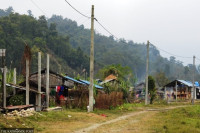National
Politicians and analysts in Nepal await developments as India-China clash threatens regional security
Lodged between the two nuclear-armed neighbours and with thousands of Nepalis serving in the Indian Army, Nepal has much at stake in any conflict involving India, analysts say.
Anil Giri
A violent clash on Monday between Indian and Chinese armies in the disputed Galwan Valley resulted in the death of at least 20 Indian soldiers and an unknown number on the Chinese side has sent shock waves across the globe. All of South Asia, and Nepal especially, is watching with bated breath for developments regarding the first casualties on the India-China border in 45 years.
At a time when Nepal and India are engaged in their own boundary row in the Kalapani region, which includes the tri-juncture between India, China and Nepal, government officials, politicians and analysts are all carefully watching how things will evolve.
Foreign Minister Pradeep Gyawali told the Post that Nepal, as a country situated between the two nuclear-armed nations, is very much concerned about the violent confrontation between India and China.
“The events should not have a spillover effect on the region,” said Gyawali. “We are following the situation very closely.”
Though the Nepal government will not yet take a public position over the unfolding events, Gyawali said that Nepal believes in de-escalation and is concerned about Gorkha soldiers serving in the Indian Army.
The Indian Army has seven Gorkha regiments with over 30,000 members. Many Indian Gorkhas are deployed along India’s fractious borders, including at the Line of Control with Pakistan.
Politicians too have taken note of the clash, expressing concern.
The serious military clashes between India and China and the resulting casualties are a matter of great concern, former foreign minister Prakash Sharan Mahat said on Twitter.
“If it escalates further [it] pose[s] [a] threat to regional peace,” he said. “[For] Nepal, as a friendly neighbour, it is a matter of great concern. Let us hope for peaceful resolution of the crisis.”
After the incident on Monday night, India’s Ministry of External Affairs on Tuesday said that the violent face-off was the result of an attempt by the Chinese side to “unilaterally change the status quo in the region”.
China’s Ministry of Foreign Affairs responded on Wednesday, saying that it was Indian troops who illegally crossed the border and attacked the Chinese.
This led to “a serious physical confrontation between both sides that caused deaths and injuries”, said Chinese foreign ministry spokesperson Zhao Lijian during a regular press briefing in Beijing. Zhao did not provide any details on Chinese casualties, which Indian sources speculate as numbering around 40.
Later on Wednesday, Indian Prime Minister Narendra Modi, for the first time, publicly acknowledged the clash, saying that India will “defend every stone, every inch of its territory.”
“I would like to assure the nation that the sacrifice of our jawans will not be in vain,” Modi said at a televised meeting of Indian chief ministers.
But in the wake of the incident with China, India is likely to be softer in its border dispute with Nepal, Mrigendra Bahadur Karki, executive director of the Center for Nepal and Asian Studies, a think-tank at Tribhuvan University, told the Post.
“India knows the importance of its Gorkha soldiers so it will be softer, or even silent, in its border row with Nepal,” said Karki.
But Nepal, too, should avoid escalating the situation on its end, as India is already on edge following the clash with the Chinese.
“I am of the personal view that the Army chief and chief of the Armed Police Force should not have visited Darchula on Wednesday, given the sensitive timing,” said Karki. “This could further the Indian perception that Nepal raised the boundary dispute with India at the behest of China.”
Nepal Army chief Purna Chandra Thapa and Armed Police Force chief Shailendra Khanal visited a border outpost set up recently in Chharung, Darchula, following the boundary dispute with India.
The Nepal-India border row arose when India opened a link road in early May via the Nepali territory at Lipulekh to Kailash Mansarovar in the Tibet Autonomous Region of China. Nepal had objected formally, asking for diplomatic talks to resolve the issue. India only responded to say that talks would be held after the Covid-19 pandemic. But Indian Army chief MM Naravane had said that Nepal was raising the boundary issue at the best of “someone else”, alluding to China.
Despite the border dispute, the clashes are going to be difficult diplomatically for Nepal, which has long pursued a policy of non-alignment. Nepal might have to make difficult choices in hard times, say observers.
“Nepal’s foreign policy does not allow it to be aligned with any particular country,” political analyst Chandra Dev Bhatta said. “But the reality is that we cannot have the same relations with all countries. In the case of India, we have our citizens serving in the Indian Army and we are still bound by the Treaty of Peace and Friendship.”
However the situation evolves, Nepal will need to redefine how it wants to conduct its relations in the neighbourhood and beyond, said Bhatta.
India and China might have a much more contested border than Nepal does with either country, but it is necessary for Nepal to look at developments through a geostrategic lens, according to former Nepal Army General Binoj Basnyat.
“The strategic importance of the entire Himalayan arc is surfacing and this includes the Kalapani region, which Nepal, by incorporating into its official map, turned from ‘occupied’ to ‘disputed’,” said Basnyat. “The Kalapani region is militarily vital for China and India and now, control over it is all the more crucial for India.”
According to Basnyat, while resolving the border dispute with India, Nepal should also revisit the 1961 Border Agreement with China.
“Nepal cannot afford to get caught in the midst of another geopolitical contest in the Himalayas,” he said.




 8.12°C Kathmandu
8.12°C Kathmandu










%20(1).jpg&w=300&height=200)



